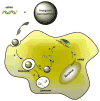Rigid nanoparticle-based delivery of anti-cancer siRNA: challenges and opportunities
- PMID: 24013011
- PMCID: PMC3947394
- DOI: 10.1016/j.biotechadv.2013.08.020
Rigid nanoparticle-based delivery of anti-cancer siRNA: challenges and opportunities
Abstract
Gene therapy is a promising strategy to treat various genetic and acquired diseases. Small interfering RNA (siRNA) is a revolutionary tool for gene therapy and the analysis of gene function. However, the development of a safe, efficient, and targetable non-viral siRNA delivery system remains a major challenge in gene therapy. An ideal delivery system should be able to encapsulate and protect the siRNA cargo from serum proteins, exhibit target tissue and cell specificity, penetrate the cell membrane, and release its cargo in the desired intracellular compartment. Nanomedicine has the potential to deal with these challenges faced by siRNA delivery. The unique characteristics of rigid nanoparticles mostly inorganic nanoparticles and allotropes of carbon nanomaterials, including high surface area, facile surface modification, controllable size, and excellent magnetic/optical/electrical properties, make them promising candidates for targeted siRNA delivery. In this review, recent progresses on rigid nanoparticle-based siRNA delivery systems will be summarized.
Keywords: Gene delivery; Gene therapy; Nanoparticles; RNA interference (RNAi); Small-interfering RNA (siRNA).
© 2013.
Figures






Similar articles
-
Nanocarrier Mediated siRNA Delivery Targeting Stem Cell Differentiation.Curr Stem Cell Res Ther. 2020;15(2):155-172. doi: 10.2174/1574888X14666191202095041. Curr Stem Cell Res Ther. 2020. PMID: 31789134 Review.
-
Nanoparticle-siRNA: A potential cancer therapy?Crit Rev Oncol Hematol. 2016 Feb;98:159-69. doi: 10.1016/j.critrevonc.2015.10.015. Epub 2015 Oct 31. Crit Rev Oncol Hematol. 2016. PMID: 26597018 Review.
-
Stimuli-responsive hybrid nanocarriers developed by controllable integration of hyperbranched PEI with mesoporous silica nanoparticles for sustained intracellular siRNA delivery.Int J Nanomedicine. 2016 Dec 8;11:6591-6608. doi: 10.2147/IJN.S120611. eCollection 2016. Int J Nanomedicine. 2016. PMID: 27994460 Free PMC article.
-
Bioengineered nanoparticles for siRNA delivery.Wiley Interdiscip Rev Nanomed Nanobiotechnol. 2013 Sep-Oct;5(5):449-68. doi: 10.1002/wnan.1233. Epub 2013 Jul 2. Wiley Interdiscip Rev Nanomed Nanobiotechnol. 2013. PMID: 23821336 Free PMC article. Review.
-
A comprehensive update of siRNA delivery design strategies for targeted and effective gene silencing in gene therapy and other applications.Expert Opin Drug Discov. 2023 Feb;18(2):149-161. doi: 10.1080/17460441.2022.2155630. Epub 2022 Dec 17. Expert Opin Drug Discov. 2023. PMID: 36514963 Review.
Cited by
-
Nanocarrier-Based Eco-Friendly RNA Pesticides for Sustainable Management of Plant Pathogens and Pests.Nanomaterials (Basel). 2024 Nov 22;14(23):1874. doi: 10.3390/nano14231874. Nanomaterials (Basel). 2024. PMID: 39683262 Free PMC article. Review.
-
The Progress and Promise of RNA Medicine─An Arsenal of Targeted Treatments.J Med Chem. 2022 May 26;65(10):6975-7015. doi: 10.1021/acs.jmedchem.2c00024. Epub 2022 May 9. J Med Chem. 2022. PMID: 35533054 Free PMC article. Review.
-
Delivery of therapeutic small interfering RNA: The current patent-based landscape.Mol Ther Nucleic Acids. 2022 Jun 22;29:150-161. doi: 10.1016/j.omtn.2022.06.011. eCollection 2022 Sep 13. Mol Ther Nucleic Acids. 2022. PMID: 35847171 Free PMC article.
-
Tackling breast cancer chemoresistance with nano-formulated siRNA.Gene Ther. 2016 Dec;23(12):821-828. doi: 10.1038/gt.2016.67. Epub 2016 Sep 20. Gene Ther. 2016. PMID: 27648580 Free PMC article. Review.
-
Theranostic multimodular potential of zinc-doped ferrite-saturated metal-binding protein-loaded novel nanocapsules in cancers.Int J Nanomedicine. 2016 Apr 1;11:1349-66. doi: 10.2147/IJN.S95253. eCollection 2016. Int J Nanomedicine. 2016. PMID: 27099495 Free PMC article.
References
-
- Ai H, Flask C, Weinberg B, Shuai X, Pagel MD, Farrell D, et al. Magnetite-loaded polymeric micelles as ultrasensitive magnetic-resonance probes. Adv Mater. 2005;17:1949–52.
-
- Alivisatos AP. Semiconductor clusters, nanocrystals, and quantum dots. Science. 1996;271:933–7.
-
- Anderson DC, Nichols E, Manger R, Woodle D, Barry M, Fritzberg AR. Tumor-Cell Retention of Antibody Fab Fragments Is Enhanced by an Attached Hiv Tat Protein-Derived Peptide. Biochem Bioph Res Co. 1993;194:876–84. - PubMed
-
- Bergers G, Benjamin LE. Tumorigenesis and the angiogenic switch. Nat Rev Cancer. 2003;3:401–10. - PubMed
Publication types
MeSH terms
Substances
Grants and funding
LinkOut - more resources
Full Text Sources
Other Literature Sources

